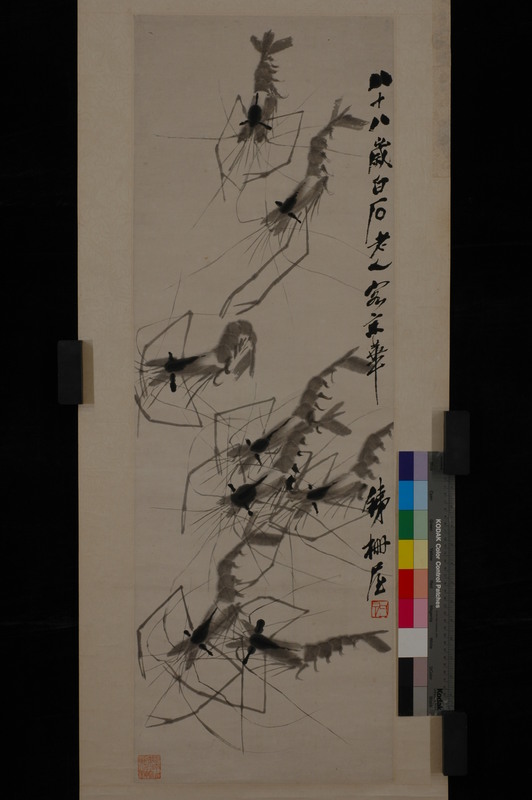Shrimps Playing Around (hanging scroll) by Qi Baishi

Measurements: Length: 99cm, Width: 34cm
Created in 1948 and collected by Hunan Provincial Museum in 1950s.
Qi Baishi, born in Xiangtan, Hunan Province was the top ten painters in the 20th century. He was one of the world cultural celebrities. There is a saying in modern China’s painting community that “Xu Beihong is famous for painting horses while Qi Baishi is renowned for painting shrimps”. The shrimps painted by Qi Baishi are very lifelike, vivid and dynamic, fully demonstrating the essence of Chinese ink painting (also known as Traditional Chinese Painting): presenting the elegance, grace, charm and vivacity. His painting of shrimps was an everlasting legacy in Chinese ink painting. Qi Baishi had raised shrimps for several decades, so as to observe them closely. This contributed to his breathtaking paintings of shrimps. Later, people said metaphorically that when Qi Baishi was painting shrimps, the blank rice paper immediately turned into a stream of clean water with shrimps in Qi’s mind. Shrimps Playing around is a masterpiece of Qi Baishi. This piece of art was created when Qi Baishi was eighty-eight years old, a period when he techniques of painting shrimps became mature. Eight shrimps are depicted in this picture with simple lines, but full of vitality and vivacity. They are well integrated to the whole scene while each shrimp displays distinctive features from others. The competence of a painting master is finely presented. It is no wonder that shrimps, the small and obscure animals would become the subjects of world-renowned paintings by the effort and brush of a painting master.
深入探索
Born to a peasant from Xiangtan, Hunan, Qi became a carpenter at 14; while growing up, he came upon a Chinese manual of painting, drawing in the garden of mustard seeds; this was what sparked his interest in art and painting.
Qi Baishi started receiving artistic training from Hu Qinyuan which consisted of fundamentals in gongbi mode, which features fine brushwork and meticulous detail. He was taught that every aspect of painting mattered, from the subject matter to the way the paint was applied to the paper. His landscape paintings came as a result of his next mentor Tan Pu. Because of his training, he then realized that he could peruse art as his full time career instead of just dreaming to become a professional artist.
Qi Baishi didn’t have any formal education or training in the field of art; however, he managed to master many different techniques including calligraphy and seal-carving. The subjects of his paintings include almost everything, commonly animals, scenery, figures, toys, vegetables, and so on. He theorized that "paintings must be something between likeness and unlikeness, much like today’s vulgarians, but not like to cheat popular people". In his later years, many of his works depict mice, shrimps and birds.
After he turned 40, he travelled, visiting famous scenic spots in China. After 1917 he settled in Beijing. In his later years, he continued to make "later-year innovations."
What is unique about Baishi is that all of his works show no western influences which were different from artists at this time. Other artists praised Baishi for his “freshness and spontaneity that he brought to the familiar genres of birds and flowers, insects and grasses, hermit-scholars and landscapes”. Even though Baishi wasn’t the first artist to focus on small things in nature, he was recognized for his very careful and beautiful way of painting such common images.
In 1953 he was elected to the president of the Association of Chinese Artists. He died in Beijing in 1957.



